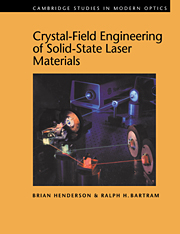Book contents
- Frontmatter
- Contents
- Preface
- 1 An introduction to lasers
- 2 Symmetry considerations
- 3 Optical crystals: their structures, colours and growth
- 4 Energy levels of ions in crystals
- 5 Spectra of ions in crystals
- 6 Radiationless transitions
- 7 Energy transfer and excited state absorption
- 8 Covalency
- 9 Engineering the crystal field
- 10 The crystal field engineered
- References
- Index
8 - Covalency
Published online by Cambridge University Press: 24 September 2009
- Frontmatter
- Contents
- Preface
- 1 An introduction to lasers
- 2 Symmetry considerations
- 3 Optical crystals: their structures, colours and growth
- 4 Energy levels of ions in crystals
- 5 Spectra of ions in crystals
- 6 Radiationless transitions
- 7 Energy transfer and excited state absorption
- 8 Covalency
- 9 Engineering the crystal field
- 10 The crystal field engineered
- References
- Index
Summary
Ligand-field theory
Limitations of crystal-field theory
The limitations of crystal-field theory became apparent soon after its formulation by Bethe (1929). Van Vleck, who was primarily responsible for its early applications, recognized that the point-ion model on which it is based is quantitatively unreliable, and proposed an alternative formulation based on covalent bonding [Van Vleck (1935), Van Vleck and Sherman (1935)], now called ligand-field theory [Ballhausen (1962)]. Nevertheless, the popularity of crystal-field theory with adjustable parameters remains undiminished, contrary to expectation [Jørgensen (1971)]. By virtue of its elegance and relative conceptual simplicity, it continues to provide a useful framework for summarizing and interpolating empirical spectral information [Morrison (1992), Kaminskii (1996)].
The essential similarity of ligand-field theory and crystal-field theory is attributable to the underlying symmetry of the complex, and its implications for the wave functions and energy levels involved. However, ligand-field theory has the capacity to explain phenomena not contemplated in crystal-field theory, such as the nephelauxetic effect discussed in §4.4.8 and §9.6.3 and transferred hyperfine interactions [Spaeth et al. (1992)]. In addition, models based on covalency provide a deeper understanding of optical properties addressed in preceding chapters, and may ultimately yield quantitatively reliable predictions of crystal-field parameters.
Molecular orbitals
In the molecular-orbital theory of covalency [Hund (1927b), Mulliken (1928)], electrons occupy orbital wave functions which are delocalized over the entire complex consisting, for example, of a transition-metal ion and its immediate ligands. An approximate molecular orbital can be constructed as a linear combination of atomic orbitals (LCAO).
- Type
- Chapter
- Information
- Crystal-Field Engineering of Solid-State Laser Materials , pp. 222 - 252Publisher: Cambridge University PressPrint publication year: 2000



